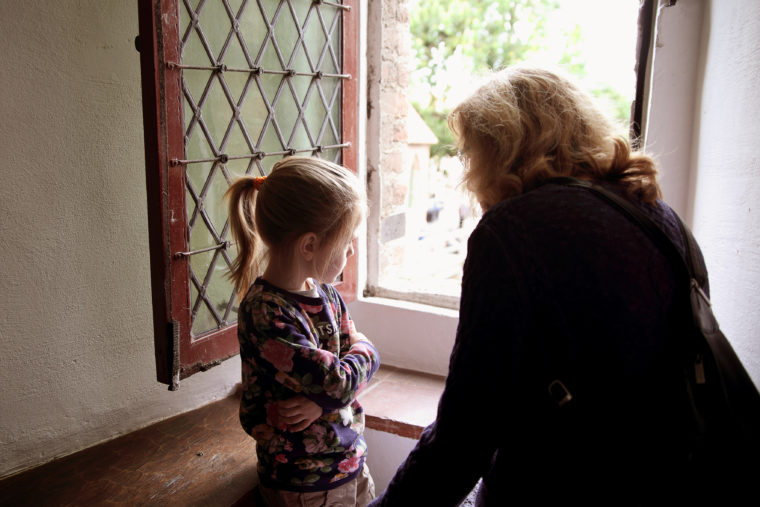As parents, we do so much to support our children in their happiness.
We make sure to get just the right balance of peanut butter and jelly on their sandwich, stock their favorite cereal, keep their comfiest pairs of socks washed and ready, and give them their favorite color cup at lunch, along with a hundred other little actions to show we care about them each day.
Often these actions can feel like sweet bits of love we shower on our children to say, “I see you,” “I care about you,” and “I want your life to go well.”
We ardently want their happiness!
And yet, life cannot always run the way our children want or prefer.
Much like us, if our children are feeling generally good inside, they weather these little disappointments well. They willingly have toast for breakfast instead of cereal or wear the socks that don't feel quite as good as their favorites.
But also like us, they can go into crisis mode over the littlest things. Think about the barista not getting your coffee order right when you're already running late, or the wifi being down right when you want it most. These are the adult equivalents of not getting your PBJ made just right or the red cup you wanted!
When our children tailspin into a fury of upset over what seems like a small disappointment it's hard to be patient. In these moments we often just want our child to relax and realize it's not the end of the world.
We try to reassure them, “I'll get more cereal tomorrow. Have toast instead,” or “You can wear these socks. I'll get the other ones washed today.”
But when the meltdown continues, these moments can send us to the brink of frustration and anger. We feel that all of our efforts to make their life go well are unappreciated. How dare they complain about the dinner we worked so hard to prepare for them! Or fuss about the laundry not being done or their cereal running out!
You can hold a limit calmly, even when your child is melting down
 To get through this kind of moment, though, our children don't need a limit on their feelings, but rather a loving expectation that they can make it through these feelings.
To get through this kind of moment, though, our children don't need a limit on their feelings, but rather a loving expectation that they can make it through these feelings.
If your children “lose it” over what seem like small matters to you, there's a good chance some unresolved tensions are making it hard for them to see beyond their upset.
These are good times to step out of “fix it” mode and step into “listening mode,” offering your confidence in them to work it through.
Listening to a highly emotional child isn’t something that has been modeled for us well, and most of us feel quite unsure of ourselves as we try. To help your child through the emotional storm in a way that builds confidence, connection, and resilience, you can experiment with these steps.
First, move close to your child and hear them out
Find out what's happening for her in the moment by taking a moment to just listen. When you jump straight to logic or fixing, your child may receive a message different from what you intended. She may hear she shouldn't feel the way she feels now because it will be different later. Or she may internalize the message she can't handle her own feelings because you jump in to fix each thing she doesn't like so that she doesn't get upset. Try to simply stay in the present moment with her first, and listen. For her, there is a problem, and listening to her will begin to help her resolve it.
Is an adjustment or reassurance needed?
After listening, you may find your child needs more information, some help fixing a problem or simply some reassurance that all is well. Letting your child know the socks they like are in the wash or that you plan to pick up more cereal tomorrow can reassure them you’re thinking of them and in charge of the situation.
The adjustments or reassurances you offer can vary from situation to situation. This is where you need to rely on your own good thinking as a parent. You know your child the best. If your child struggles with accepting new foods, it may make sense to offer her something different at one meal but not at another. Use your best judgment as you take in the whole situation, what you know about your child, and your own state in that moment. If you do offer an alternative and it doesn't help, there's a good chance some built up feelings are blocking her way toward accepting the solution.
Let them experience their feelings and offer your caring and warm attention.
 If your child’s upset continues, then the best thing you can do is stay and listen, what Hand in Hand Parenting aptly called “Staylistening.” Stay close to your child.
If your child’s upset continues, then the best thing you can do is stay and listen, what Hand in Hand Parenting aptly called “Staylistening.” Stay close to your child.
Let her know you care and will stay with her while it's hard. You don't have to convince her of anything. Your job is to stay loving and confident that life can still be good even though she's not getting the exact thing she wants in that moment.
You can show your confidence in your child by using simple statements like, “I’m sorry it’s hard right now. I’m here for you.”, “I know you can find something else to do. You’ll figure it out.”, and “I really want things to go well for you. This won’t last forever.” These types of reassurances, where you offer support and listening, can help your child move to the next step of working through the tensions blocking her ability to be pleased with herself and life.
Here's how setting a limit calmly can work:
When having friends over for a chili dinner, one of the children invited (who has a history of struggling with food and sensory issues) took one look at the chili I made and went into meltdown mode. He absolutely lost it, just from looking at the chili! He cried and cried that it wasn't like the chili he was used to at his house. I've known this family for a while and have a relationship with the child so was able to come close and listen. I let him know I heard him and I was sorry it was hard for him that the dinner wasn't like he was expecting.
After some moments of listening to his upset, he yelled back at me, “Did you ever think to ASK someone how they like their chili? Huh? Did you think of THAT?!” I knew he wasn't being rude or disrespectful, he was in genuine distress over this. I told him gently that I hadn't thought to do that and that I trusted he could try the chili and see if he liked it. He cried more, telling me how I “should” have handled things. I listened, maintaining warm and friendly eye contact with him. Now and then, I proposed the chili might be good even though it was different from what he was used to.
He worked hard on his feelings of upset. He cried because it was different, and he was sure it was going to be horrible. I kept listening, staying warm and loving toward him, letting him know that I thought it was safe to try the chili and that I really believed he could do it.
I could tell that each gentle reassurance and confidence I held out to him was sinking in. He would pause, taking it in, like he was really sifting it around in his mind, and then he'd go right back to the emotional work finding another aspect of the dinner to be upset about.
At one point he cried that I hadn't asked him about the onions and green peppers in it. He let me know he had seen me chopping them, but he didn't think I'd put them in the chili. I reminded him that he did have choice and power here and he could pick them out if he wanted. This suggestion brought up even more feelings of powerlessness and he thrashed about saying there was no way he could EVER pick them all out. I stayed close and let him know I was happy to help him. He had my support. He wasn't alone in this. As his upset slowed I let him know I really wanted mealtimes to go well for him and to feel good to him. He cried and stormed more, sometimes trying to hit or kick at me. I used some couch pillows to block him and held the limit that I wouldn't let him hurt me.
After about 30 minutes his emotions had shifted enough that we were able to make it to the table together. His anxiety was still high and his breathing elevated as he sat at the table close to me. We offered him a bowl with the peppers and onions mostly picked out to help ease his anxiety. (Were this a different child or situation I may not have done that, but for this child, the anxiety around food is so high, I wanted to ease his anxiety and show support for him.)
He stared at his bowl, clearly still stressed by the prospect of eating its contents. I offered gentle reassurance that I was there to support him but mostly I just stayed quietly by his side. He used his fingers to poke at the beans. Slowly he became more playful with the food. I stayed relaxed with him as he explored it, smooshing a few of the beans between his fingers. After sharing a couple giggles together he moved to taking one bite and then another, and then another. Success! The fear of the chili being different had moved enough that he could face the bowl and eat with me.
With some children, a supportive listening time like this can lead to big changes, and you may notice hot-button issues disappear overnight. For others, like this boy, the issue is more complex, and it will most likely take many listening times to work through the anxiety. Hand in Hand calls releasing these more deeply rooted feelings an “emotional project.”
When holding an expectation for your child, remember to keep it small and appropriate for your child. And when there is a good chunk of fear or anxiety, it's important to keep the expectation even smaller and move very slowly. In time, you will see your child’s confidence and resilience grow as you support them through life's little and big disappointments.
More from the Hand in Hand Toolbox
You can learn more about this way of setting limits in the book Listen: Five Simple Tools To Meet Your Everyday Parenting Challenges by Patty Wipfler and Tosha Schore.
Find out why playful limits can be more effective than direct orders in Three Steps to Setting Limits
Get a free download of this guide to setting limits without yelling, blaming or shame.
Meet the teachers listening to kids and bringing Hand in Hand’s tools to classrooms
Why is your child so angry?
Find out why your child feels so angry and how you can use connection to co-regulate.
Click here to get your free guide now.
Save


